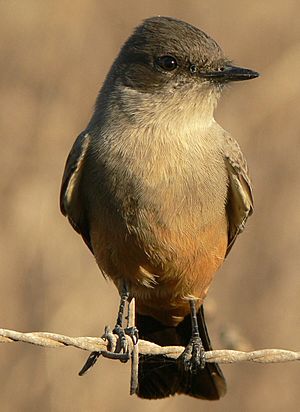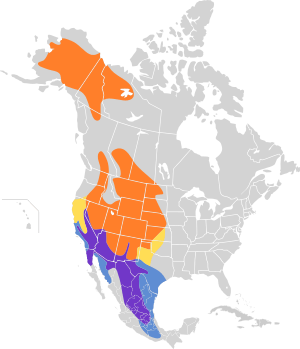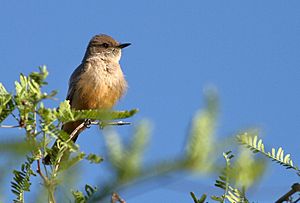Say's phoebe facts for kids
Quick facts for kids Say's phoebe |
|
|---|---|
 |
|
| Conservation status | |
| Scientific classification | |
| Genus: |
Sayornis
|
| Species: |
saya
|
 |
|
The Say's phoebe (Sayornis saya) is a type of passerine bird. This means it's a perching bird, like many songbirds. It belongs to the tyrant flycatcher family. You can often find this bird in the western United States. It likes dry, empty areas. This bird got its name from Thomas Say, who was an American naturalist.
Contents
About Its Name and Family
A French naturalist named Charles Lucien Bonaparte first officially described the Say's phoebe in 1825. He found a specimen, which is a sample animal, near Pueblo, Colorado. He gave it the scientific name Muscicapa saya. The "saya" part of the name was to honor Thomas Say.
Later, in 1854, Bonaparte put this bird into a new group, or genus, called Sayornis.
There are two main types, or subspecies, of Say's phoebe:
- S. s. saya (Bonaparte, 1825) – This type lives in Alaska, western Canada, the western USA, and southern Mexico.
- S. s. quiescens Grinnell, 1926 – This type is found in Baja California, which is in northwest Mexico.
What Does It Look Like?
An adult Say's phoebe has a round, "barrel-chested" body and a square-shaped head. Its back is gray-brown, and its tail is black. The underside of its body is a buffy cinnamon color. This color becomes more orange near its vent, which is where waste leaves its body.
Its tail is long. When the bird is resting, its main wing feathers, called primaries, go just past its rump (the back part of its body). When it flies, its wings look pale. They can look a bit like the wings of a female mountain bluebird.
Young Say's phoebes look similar to adults. However, they have buffy orange or whitish bars on their wings. They also have a yellow gape, which is the corner of their mouth. Adult birds are about 7.5 in (19 cm) long. Their wings can spread about 13 in (33 cm) wide. They weigh around 0.75 oz (21 g).
Where Do Say's Phoebes Live?
You can find Say's phoebes all year round in some areas. These include western Colorado, southwest to southern California, and east to western Texas. They also live south through western Mexico.
They travel to breed in the spring. Their breeding areas stretch from Alaska south through western and south-central Canada. They also breed south through North Dakota, the midwest USA, and to New Mexico and westward.
In winter, they fly south. They spend the colder months in the desert southwest of the USA, southern Texas, and south through Mexico to northern Central America. Sometimes, these birds can fly thousands of miles away from their usual areas during migration. They are often seen in New England, USA, and Nova Scotia, Canada, in the fall.
These birds like dry, empty, and arid places. You might see them on farms, in savannas, or in open woodlands. They usually stay close to water. They are often some of the first birds to migrate to the western U.S. in the spring.

Say's Phoebe Life and Habits
The Say's phoebe acts a lot like the eastern phoebe. It hunts insects by flying out from a perch to catch them in the air. This is called "sallying." It can also hover in the air, like an American kestrel. When it's sitting, it often dips its tail up and down. Say's phoebes also like to hunt for food just above the water's surface. They mostly eat insects. However, they have also been seen eating berries sometimes.
Say's phoebes build their nests in a way that is common for phoebes. They attach their nests under bridges, on canyon walls, inside wells, and in old mine shafts. The female bird builds the nest. It is shaped like a cup. She uses grass, forbs (small plants), moss, and plant fibers. She lines the inside with hair and other soft materials. She usually lays four or five eggs, but sometimes three to seven. The eggs are white and mostly plain, but some might have red spots. Each egg is about 0.8 in (20 mm) long.
Images for kids
See also
 In Spanish: Mosquero llanero para niños
In Spanish: Mosquero llanero para niños



